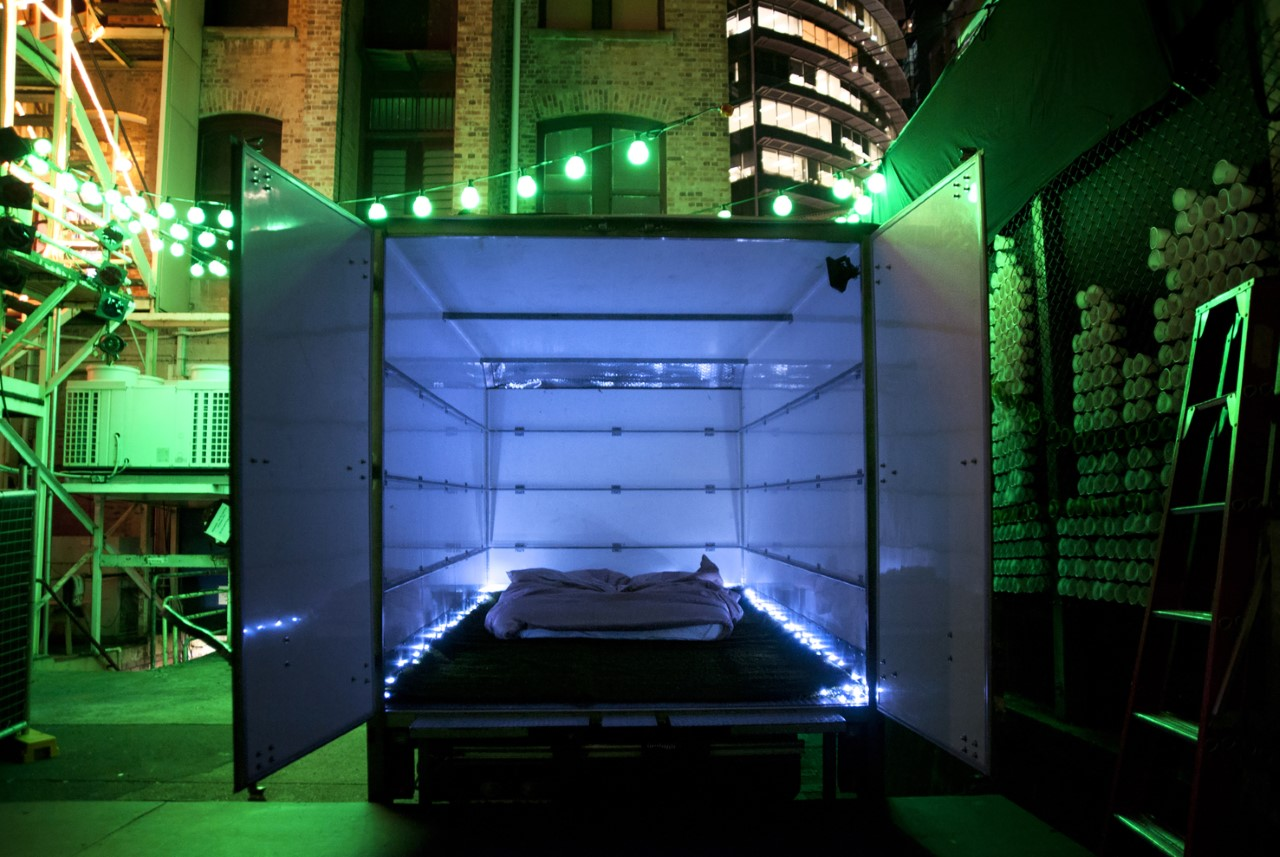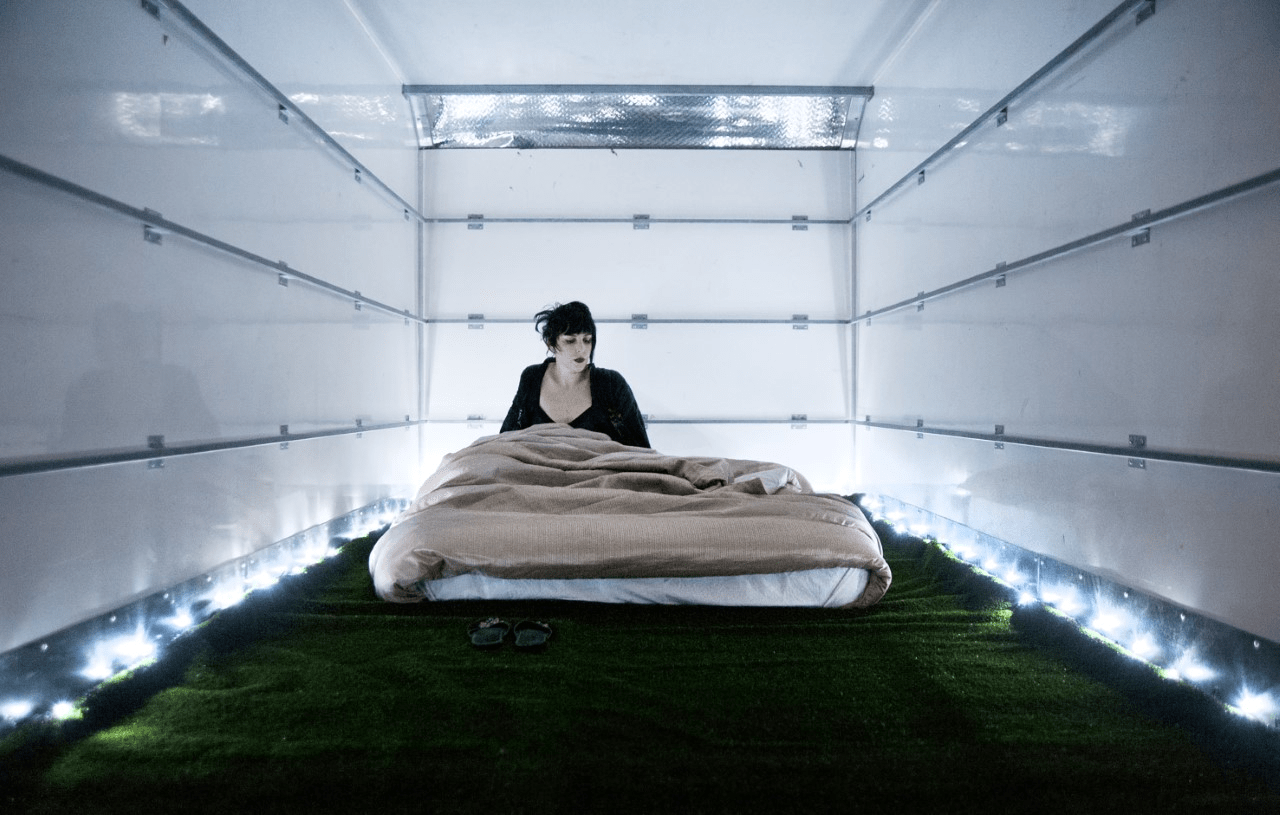


Homesickness, but there’s no home to go to.
On this overcast Sunday evening I recall curator Jeff Khan’s phrase from an artist’s panel the previous day. His throwaway line lingers, as if he said it directly to me. Do I still have a home? If so, where is it?
It’s the final night of Khan’s annual festival Liveworks and I’ve secured a last minute ticket to its most intimate show. Having given over my iPhone, I venture down a deserted lane besides Carriageworks. I remember how desolate this area still feels. No well-dressed arts crowd, no people at all, just empty industrial sheds.
I reach a small rental truck. A woman silently leads me into its enclosed metal chamber and shuts the door behind me. The interior feels like Marie Kondo’s perfect bedroom. Just two items of furniture - an animal rug and a low double futon – gently lit by a wall of fairy lights.
In the bed lies a figure, apparently sleeping. Next to them the crumpled bedclothes are upturned. I don’t know what I’m meant to do. Without instructions I have to make up this encounter, invent its vocabulary. For a time I stand and avoid looking anywhere. Then a sleepy arm beckons me. I pull myself into the bed and my awkwardness immediately amplifies. I lie, stiff, staring at a crack of light in the door. Trains flash past and our little steel room feels very fragile.
Suddenly I am a teenager again. I remember countless nights lying next to strangers alternating between optimism, terror and shame. Will we make out? Will we talk for hours? What is my role and what is my agency? If I don’t make a move, like all good male protagonists should, is the subsequent neutrality my fault? I seem to remember never getting much further than this.
Gradually the arm reaches across and draws me over. I cuddle up to my companion’s body. I see, up close, their jagged undercut and I feel the curve of their stomach. I recognise them from yesterday’s talk as the work’s artist, S.J Norman. In public they seemed distant, punkish; now, at rest, they are closer to me than anyone in the world. As I haven’t yet read the program note I do not realise that the artist is not always present. I might have lain with one of a roster of delegates, male or female. I imagine a huge difference in vulnerability between facing the artist unmediated and someone a step removed.
After a while Norman turns to me and I catch their breath, sweetly neutral. They nudge me over and now put their arm around me. I don’t remember the last time I was cradled like this. In this moment I feel so cared for, like we’ve known each other for years. Yet soon the truck door will re-open and I will be replaced by another. My convoy will experience an entire romantic history compressed into two and a half hours.
‘No home to go to.’ I think again of Khan’s words and of another phrase that was always so exotic on museum wall labels: ‘lives and works in city X and city Y.’ Such transcontinental cosmopolitanism seemed the ultimate unreachable arbiter of art success. Recently, I somehow half-moved to New York. Now I have no idea where home is. In my newly-rewritten life my only knowns are where I’ll spend the next night or two; maybe a couch, maybe a hotel, maybe a room I have rented for a week or perhaps longer. Until now, it’s never come to a truck stop. My sense of self extends no further than the physical limits of my body. These limits at least I can trust.
In this new vacuum the biggest thing I crave is touch. My initial salve – Tinder – proved a predictable misstep. Yet peripateticism makes ongoing intimacy elusive. In this context, connecting with another feels radical.
Norman created Rest Area eleven years ago. They had just returned to Sydney from the mandatory Australian gap year or two in Europe to find their relationship disintegrating, made poignant when their now-ex lover helped present the work’s first iteration. Norman has since staged it annually, this latest in Redfern a significant ‘coming home’ considering their Wiradjuri, Wonnarua and European heritage.
I think of another project born from similar circumstances. Several years earlier, Juan Mann had also returned to Sydney from London to find their sense of community, and thus of self, depleted. He set out to connect with strangers by standing in Sydney’s Pitt Street mall holding a cardboard sign inviting ‘FREE HUGS!’. Whilst Norman’s project has reached over a thousand, Mann’s has, thanks to a viral video and an eventual audience with Oprah, reached millions. Yet there seems a world of difference in this act of publicity versus our act in privacy.
On paper, Rest Area read to me as a one liner. Yet I find the experience unbearably moving. To be embraced so readily by a stranger, to be welcomed with such trust, to be drawn unconditionally into this warm and medicating environment. The security I receive is at odds with the implicit danger declared by the work’s blurb – ‘anything can happen’ – and feels all the more potent being a straight male entering a queer female space. Like Norman a decade ago, I’ve flown halfway across the world, from one world city to another, for this moment. I feel I have come home.
Yet this is also a moment of breakdown. Our connection is guaranteed to dissolve. Just as this exchange demands no expectation, it also offers no ongoing reciprocation. For a time our embrace never ends but the invigilator inevitably reappears. My fifteen minutes are up. I step back into the darkened landscape and immediately run into a friend of a friend. We smile and briefly chat before they take my place in the truck. I sniff, wipe my face, and walk up to King Street to find dinner.
Julian Day is an artist, composer and writer. He has presented work at Tate Modern, Whitechapel Gallery, MASS MoCA, California Pacific Triennial, Asia Pacific Triennial, Museum of Contemporary Art Australia, Artspace, Australian Centre for Contemporary Art and MUMA. He is currently undertaking an MFA at Columbia University in New York through the support of the Samstag Museum.
